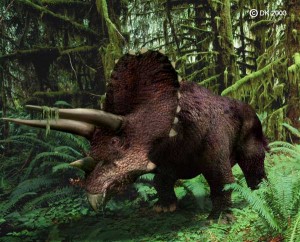A Triceratops may have been the last dinosaur standing, according to a new study that determined a fossil from Montana’s Hell Creek Formation is “the youngest dinosaur known to science.”
The Triceratops, described in the latest Royal Society Biology Letters, dates to 65 million years ago, the critical period of time associated with the Cretaceous-Tertiary (K-T) extinction event that wiped out all non-avian dinosaurs and many other animals and plants.
Since this rhinoceros-looking, three-horned dinosaur lived so close to the mass extinction moment, it could negate an earlier theory that dinosaurs gradually died out before 65 million years ago.
“Our paper suggests that dinosaurs did not go extinct prior to the impact,” lead author Tyler Lyson told Discovery News. “The fact that this dinosaur is so close to the K-T boundary lends support to the idea that they went extinct as a result of a meteorite impact.”
Lyson, a researcher in Yale University’s Department of Geology and Geophysics, and his team discovered the remains of the Triceratops, including its over 1.5-foot-long horn, just 5 inches below the pollen-calibrated K-T boundary at Camel Butte, a hill at the Hell Creek Formation in southeastern Montana.
By studying the region’s geological layers, the scientists can see how dinosaurs suddenly disappeared after the catastrophic event, which Lyson and many other experts believe was a meteorite strike that directly hit Earth at Mexico’s Yucatan Peninsula.
Lyson said that “we don’t fully understand the kill mechanism,” but other researchers “have a proposed a nuclear winter, while others have proposed a thermal pulse.”
The prior theory that dinosaurs gradually died out before 65 million years ago was often based on what is known as the “3-meter gap,” which referred to an apparent geological zone devoid of dinosaur fossils before the K-T event.
The Hell Creek Triceratops, however, was not only found within that 3-meter region, but it also exists at the upper reaches of it, proving that at least one dinosaur and presumably more were still alive when the meteorite blasted into Chicxulub, Mexico.
Co-author Stephen Chester of Yale’s Department of Anthropology told Discovery News that the Camel Butte site is important both because it has “the most recent dinosaur specimen” and “because we are finding a great diversity of small mammals that are first documented directly after the extinction event.”
Chester continued, “Although the K-T mass extinction event is mainly known for the disappearance of the non-avian dinosaurs, it is also an extremely important event in mammalian evolution because once the dinosaurs vanished, mammals underwent a large adaptive radiation and began occupying diverse ecological niches in the Paleocene.”
These mammals included condylarths, which were hoofed animals proposed to be ancestral to some modern orders of hoofed mammals. They also included multituberculates, which Chester described as being “extinct rodent-like animals with a very specialized dentition.”
It remains unclear why certain mammals, turtles and other animals survived the K-T extinction event, but Lyson explained that species with generalist, rather than specialized, diets tended to fare better, as did smaller animals and water dwellers.
Kirk Johnson is vice president of Research & Collections and chief curator at the Denver Museum of Nature & Science.
Johnson told Discovery News that he agrees the Triceratops is indeed “the last known non-avian dinosaur of the Cretaceous.” He said, “The 3M Gap is a weak concept to begin with,” and that his own work on plants and insects supports the idea that the meteor impact was the “direct and immediate cause of habitat destruction and extinction of more than 50 percent of North American plant and insect species.”
Peter Sheehan, curatorial chair of the Milwaukee Public Museum’s Department of Geology, also agrees with the new findings. He and all of the other researchers, however, suspect that more recent dinosaurs even closer to the K-T boundary will be found in the future.
For now, however, the 65-million-year-old Triceratops is the world’s last known surviving dinosaur.



 July 31st, 2012
July 31st, 2012  Riffin
Riffin 
 Posted in
Posted in 